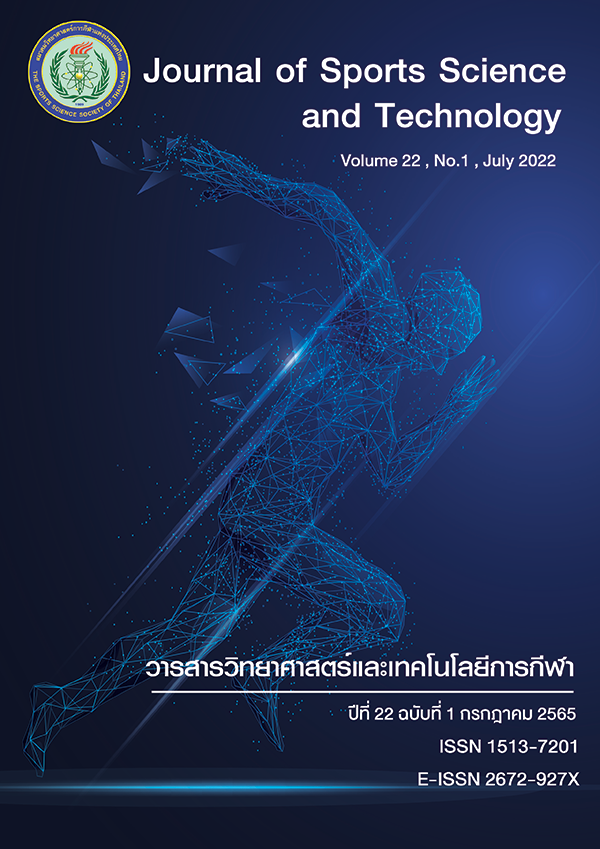QUADRICEPS FEMORIS AND HAMSTRINGS MUSCLE STRENGTH IN RECREATIONAL RUNNERS WITH DIFFERENT HAMSTRINGS MUSCLE LENGTH
DOI:
https://doi.org/10.14456/jsst.2022.7Keywords:
Hamstrings Muscle Length, Muscle Strength, Stretching, Recreational RunnersAbstract
Purpose: The purpose of the study was, to investigate quadriceps femoris and hamstrings muscle strength in different hamstring length groups of recreational runners and, secondly, to examine the association of hamstrings muscle length and knee muscle performance. Materials and Methods: Twenty healthy recreational runners who were healthy and met the inclusion criteria were included in the study. Runners hamstring muscle length was assessed using a passive knee extension test and knee muscle strengths was assessed using an isokinetic dynamometer. Data of 40 limbs were divided into 3 groups based on the knee range of motion (ROM) results from the passive knee extension test, including group 1: 130°-145° (n=14), group 2: 146°-160° (n=13), and group 3: 161°-180° (n=13). Hamstrings muscle length and knee muscle strength were reported and analyzed using One-way ANOVA was used to compare between groups and using Pearson’s correlation was used to analyze the correlation within groups. Results: Group 2 showed higher value of the hamstrings: quadriceps strength ratio (H:Q ratio), and quadriceps femoris and hamstring muscle performance. Hamstring muscle length exhibited a significantly negative correlation with quadriceps femoris and hamstring muscle strength in the group 3. Conclusion: The study indicates high knee muscle strength in the group 2 which has 146°-160° knee ROM with using a passive knee extension test. In the group 3, a greater 160° knee ROM exhibited poor knee muscle strength. In order to maintain quadriceps femoris and hamstring muscle strength, 146°-160° knee ROM is recommended in recreational runners, which could also be suggested as a rehabilitation goal, especially in runners with poor flexibility of hamstrings muscle.
(Journal of Sports Science and Technology 2022; 22 ((Online Edition))
(Received: 24 November 2021, Revised: 11 April 2022, Accepted: 18 April 2022)
Corresponding author: Pannapa LEEPOKPINYO
Biomechanics and Sport Research Unit,
Faculty of Physical Therapy, Mahidol University, Nakhon Pathom, THAILAND
E-mail: pannapa.lee@mahidol.edu
References
Tschopp M, Brunner F. [Diseases and overuse injuries of the lower extremities in long distance runners]. Z
Rheumatol. 2017;76(5):443-50.
Rakpuang S. Marathon in Thailand: Social network and challenges in 21st century. RPJ. 2019;37(1):9-11. (in
Thai)
Fields KB, Sykes JC, Walker KM, et al. Prevention of running injuries. Curr Sports Med Rep. 2010;9(3):176-82.
Arnold MJ, Moody AL. Common Running Injuries: Evaluation and Management. Am Fam Physician.
;97(8):510-6.
Messier SP, Legault C, Schoenlank CR, et al. Risk factors and mechanisms of knee injury in runners. Med Sci Sports Exerc. 2008;40(11):1873-9.
Baur H, Hirschmüller A, Müller S, et al. Is EMG of the lower leg dependent on weekly running mileage? Int J
Sports Med. 2012;33(1):53-7.
Mellinger S, Neurohr GA. Evidence based treatment options for common knee injuries in runners. Ann Transl Med. 2019;7(Suppl 7):S249.
Mongkonpattarasuk A, Sinsurin K, Warathanagassame P, et al. Lower extremity injuries and associated factors
in marathon runners: A survey study in Bangkok marathon 2013. J Sports Sci Technol. 2018;18(2):73-80. (in
Thai)
Neal BS, Lack SD, Lankhorst NE, et al. Risk factors for patellofemoral pain: a systematic review and meta
analysis. Br J Sports Med. 2019;53(5):270-81.
Brughelli M, Cronin J. Altering the length-tension relationship with eccentric exercise : implications for
performance and injury. Sports Med. 2007;37(9):807-26.
Behm DG, Chaouachi A. A review of the acute effects of static and dynamic stretching on performance. Eur J
Appl Physiol. 2011;111(11):2633-51.
McHugh MP, Cosgrave CH. To stretch or not to stretch: the role of stretching in injury prevention and
performance. Scand J Med Sci Sports. 2010;20(2):169-81.
Balle SS, Magnusson SP, McHugh MP. Effects of contract-relax vs static stretching on stretch-induced strength loss and length-tension relationship. Scand J Med Sci Sports. 2015;25(6):764-9.
Small K, Mc Naughton L, Matthews M. A systematic review into the efficacy of static stretching as part of a
warm-up for the prevention of exercise-related injury. Res Sports Med. 2008;16(3):213-31.
Hott A, Brox JI, Pripp AH, et al. Effectiveness of Isolated Hip Exercise, Knee Exercise, or Free Physical Activity
for Patellofemoral Pain: A Randomized Controlled Trial. Am J Sports Med. 2019;47(6):1312-22.
DeVita P, Aaboe J, Bartholdy C, et al. Quadriceps-strengthening exercise and quadriceps and knee
biomechanics during walking in knee osteoarthritis: A two-centre randomized controlled trial. Clin Biomech (Bristol, Avon). 2018;59:199-206.
Segal NA, Nevitt MC, Welborn RD, et al. The association between antagonist hamstring coactivation and
episodes of knee joint shifting and buckling. Osteoarthritis Cartilage. 2015;23(7):1112-21.
Deshmukh A, Sadhoo S, Meshram S, et al. Comparison of 90-90 passive hamstring stretching technique plus
knee to chest position with 90-90 passive hamstring stretching alone in normal healthy individuals of age 18 to 25 years. PJMS. 2020;8:107-12.
Malliaropoulos N, Papalexandris S, Papalada A, et al. The role of stretching in rehabilitation of hamstring injuries: 80 athletes follow-up. Med Sci Sports Exerc. 2004;36(5):756-9.
Reurink G, Goudswaard GJ, Oomen HG, et al. Reliability of the active and passive knee extension test in acute hamstring injuries. Am J Sports Med. 2013;41(8):1757-61.
Feiring DC, Ellenbecker TS, Derscheid GL. Test-retest reliability of the biodex isokinetic dynamometer. J Orthop Sports Phys Ther. 1990;11(7):298-300.
Lund H, Søndergaard K, Zachariassen T, et al. Learning effect of isokinetic measurements in healthy subjects, and reliability and comparability of Biodex and Lido dynamometers. Clin Physiol Funct Imaging. 2005;25(2):75-82.
Mukaka MM. Statistics corner: A guide to appropriate use of correlation coefficient in medical research. Malawi Med J. 2012;24(3):69-71.
Avela J, Finni T, Liikavainio T, et al. Neural and mechanical responses of the triceps surae muscle group after 1 h of repeated fast passive stretches. J Appl Physiol (1985). 2004;96(6):2325-32.






